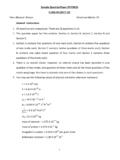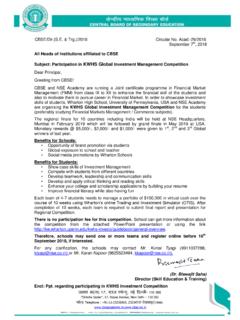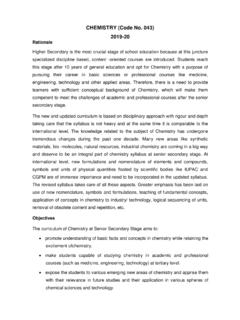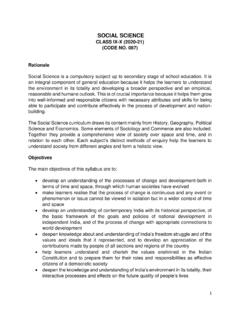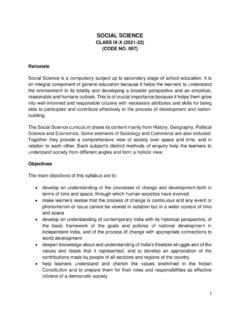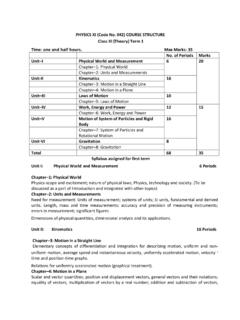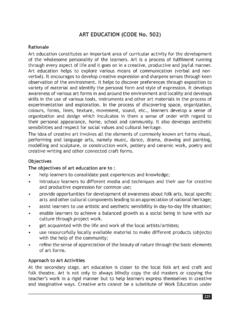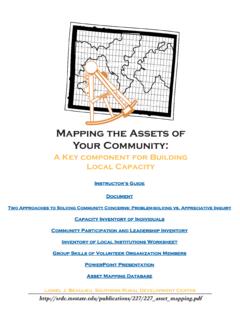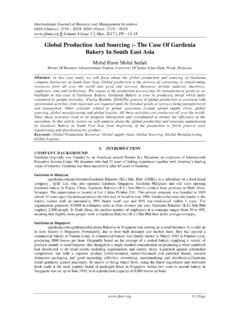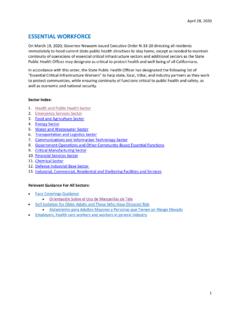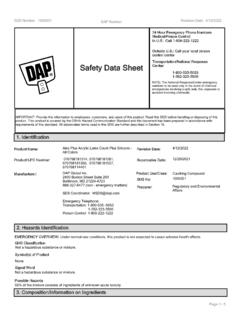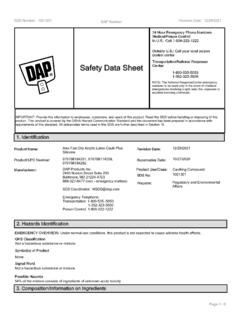Transcription of Entrepreneurial Skills Introduction
1 Entrepreneurial Skills Introduction Entrepreneurship is defined as the creation of a new business venture. However, it is important to recognize entrepreneurship is much beyond that. Entrepreneurship is everywhere. In our daily lives, we use various products and services that are provided by businesses. These businesses were created because of entrepreneurs. Entrepreneurship not only initiates creation of new businesses in different industries, but also positively impacts economic development. Entrepreneurship plays a crucial role in economic development, is characterized by dynamic economic activity and has its own rewards for the entrepreneur as well as for the economy.
2 Business Meaning and Types A business is defined as a continuous activity, where economic actions are taken by humans with the objective of earning a profit by either producing, sourcing, buying and selling of goods and services. Hence, a business refers to an organization or enterprising entity engaged in commercial, industrial, or professional activities. Businesses vary across industries and sectors. Based on economic activity, businesses are categorized in manufacturing, service and trading. Based on size, businesses are categorized into micro, small scale, medium scale and large scale.
3 Based on business model, they might be categorized differently. Based on legal form, they have to follow different procedures and norms and thus are categorized differently. Irrespective of nature, size, scale or ownership, businesses have some common features: Trade-related: Business is a trade-related activity. It involves the purchase and sale of goods or services. Economic or social motive: Usually, most businesses performs economic activities such as production, distribution, exchange, expansion etc. with the objective of earning a profit. However some businesses have the sole motive of social welfare.
4 Yet, there are other businesses which have both the motives social and economic. Presence of an entrepreneur: More than an entrepreneur, there is a forerunner in every business. This person is responsible for taking the initiative of establishing, running and growing the business, making key decisions and undertaking the risks involved with it. Regular Transactions: A business must be doing and dealing in transactions on a regular basis. An activity that involves only a one-time transaction where the transaction deals in exchange or transfer of goods and services cannot be necessarily considered as a business even if a profit is earned.
5 Uncertainty: Every business is featured with uncertainty of sales, return and success. There is no guarantee that the amount invested will come with return or the business will earn a specific amount of profit. Similarly, there is uncertainty about whether customers will choose the product or service offered. Types of Businesses A business entity is defined as an enterprise or organization that uses economic inputs or resources, converts them into goods or services and provides them to its customers in exchange for money. In line with this definition, businesses are also categorized as follows: Manufacturing Business: Manufacturing businesses source products that can be used as raw materials, with the intention of converting these materials to make an end product.
6 This new product could be something that can be directly sold in the consumer market or could be a product that can be used in the value chain. These businesses focus on transformation of one product to create a new product. Most manufacturing businesses combine raw materials, technology, labor, plant and machinery and overheads in the process of production. Some examples of such businesses include manufacturing and selling of shoes, clothes, mobile phones, laptops, suitcases, metal products etc. Service Business: As mentioned in the tertiary sector, a service business is involved into provision of intangible offering, a service that does not have a physical form but provides value to the customer.
7 Services businesses offer value using Skills , consultancy, expertise, efficiency etc. Some service businesses include banks, law firms, chartered accountants, financial consultants, beauty salons, schools, e-commerce platforms, event planners etc. Merchandising Business: Merchandising businesses involves transfer of ownership or tangible products. Most of the times, in these type of businesses, products are bought at a wholesale price and sold at retail price. These businesses profit by selling products at a higher price than the purchase cost. The form of the product is not changed by a merchandising business, but it is sold in the same form.
8 In merchandising businesses, it is important for the business to have keep enough inventory or stock. For example, convenience stores, resellers, distributors, grocery stores, supermarkets, retail clothing stores are examples of merchandising businesses. Trading Business: A trading business is also involved in reselling of goods. However, the difference between a trading business and a merchandising business is that in trading business, a trader does not necessarily have to keep stock of inventory . Trading businesses work with different kinds of products and services that is sold to consumers, businesses or government organizations.
9 Some activities trading businesses are involved in are buying of products or brokering of services, negotiating for prices and coordinating delivery. A trading business earns money from the profit margin purchase cost and selling price. Import and export of goods and services largely make up the trading sector. Some examples of trading businesses are real estate brokers, middlemen, importers, exporters, foreign exchange traders etc. Hybrid Business: Hybrid businesses are some businesses that are involved in different activities ranging from manufacturing, service, merchandising etc.
10 These could be business groups involved in different types of businesses that cannot be classified as a definite service business or a manufacturing business. It may not use the traditional methods of production and distribution. Sometimes, businesses that focus on socially beneficial goals are also termed as hybrid businesses. For example, though a traditional restaurant business is classified as a service business, some are also considered to be hybrid businesses. If they are involved in combining ingredients to make different products, they are performing a manufacturing activity.
